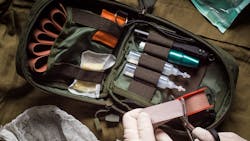10 Things an Off-Duty Officer Should Have for Trauma Care
Every experienced officer knows that when they are off-duty they stand a far greater chance of coming across a traffic accident than they do a mass shooting. Most, if they are honest when answering, would freely admit they’d rather come across the traffic accident all day every day rather than a mass shooting. While the perceived trauma is different between the two events (and that’s a topic for a separate article), the reality is that trauma care supplies are trauma care supplies and what you may need off-duty is pretty much the same no matter what the cause of the trauma was. In this article we’re going to take a look at a few items every off-duty officer should have available if possible. The “if possible” is dependent on whether or not you’re with your vehicle because unless you take a pack with you everywhere you go (and this author knows officers who do), you simply can’t carry it all.
1. The Carry Method.
Whether it’s a sling bag or a MOLLE equipment vest, you have to have a way to grab-and-go with all of the following. Vests such as Armor Express’ overt carriers (with or without ballistic inserts) are an excellent way to keep your supplies organized. For some reason, the idea of putting on a response vest readily appeals to the younger and more eager officers while the older officers lean away from all that is “tactical.” For those guys (and ladies), a sling pack or simple pack might be the way to go. It doesn’t have to be big and keep in mind that you should only be carrying what you’re trained to use anyway.
2. A tourniquet. Or five.
The number one cause of casualties in a contemporary combat zone is blood loss from an extremity. Taking a lesson from that, we should be prepared to stop that potentially fatal bleeding and the easiest, most effective way to do that is with a properly applied tourniquet. Since it’s entirely possible to need four tourniquets to treat one victim (four limbs per person, right?) then having at least that many is a good idea.
3. Hemostatic gauze.
For treating a large laceration, puncture wound, or other bleeding injury that’s in a location on the body that prohibits tourniquet use, packing the wound with a hemostatic gauze is the next best option. Most people far underestimate how much gauze is needed to pack a wound. It’s highly recommended that you have three or four packages of hemostatic cause; one for each tourniquet is a good balance.
4. EMT shears.
Whether you are an EMT or not, quite often you have to expose the wound to determine proper treatment. While plenty of officers carry a knife, on and off-duty, and claim that it’s their “rescue tool,” the reality is that knives were not made expressly to remove clothing without harming the victim—EMT shears are. Get a good quality pair and keep them accessible in your kit. You’re likely to need them before you need other items for treatment.
5. Pressure bandages.
If you’ve had to use hemostatic gauze, you’re going to need something to keep it all held in place while providing pressure over the wound sights. Pressure bandages are designed to do exactly this. Regular gauze wraps simply don’t provide a method for creating and maintaining the desired pressure over the wound.
6. An assortment of adhesive bandages.
Keep in mind that what you may end up treating won’t be a traumatic injury, but what we’d affectionately call a “boo boo.” Get out the boo-boo bandages (a.k.a. Band-Aids) of appropriate size and, after cleaning off the wound site, apply the bandage. Remember that the wound might be a torn hangnail or a shallow cut or a skinned knee.
7. Sterile wipes or other disinfecting agent.
Before bandaging any wound, provided it’s below the “traumatic” threshold, you should clean it. Sterile or anti-septic wipes, sterile water and other products are available for this purpose. Whatever you choose, make sure that if it’s liquid, the container is robust enough not to be broken or damaged enough to leak while it’s bumping around in your trunk.
8. A penlight.
While most of us don’t have the training to diagnose concussions or other conditions that would affect pupil dilation, we all do know that pupils should contract when a light is shown into them. For this purpose, testing pupils, you don’t need a 1,500 lumen light. In fact, that would be bad and potentially cause harm to the patient. A small penlight, such as the 11 lumen stylus light from Streamlight, would work just fine.
9. Nitrile gloves and a CPR mask.
Lumped as one item because they are both to protect the person giving the care rather than the person receiving it, these two pieces of personal protective equipment (PPE) should be considered mandatory in every trauma/medical kit. More victims means more PPE. Carry five or more sets.
10. A permanent marker, affectionately referred to as a “Sharpie.”
Black is fine. You’re going to use it to note treatment and vitals along with the date and time you wrote the information, provided you have the training to take the vitals and provide any treatment. Keep in mind that putting on a tourniquet is providing treatment so just being able to note that is good.
Several companies make trauma or first-aid kits that contain all of the above in neatly packaged carriers—pouches, packs, etc. For purchasing kits, we recommend you check out Chinook Medical and Adventure Medical Kits. For purchasing individual items, North American Rescue seems to be the choice of many tactical medics.
About the Author
Lt. Frank Borelli (ret), Editorial Director
Editorial Director
Lt. Frank Borelli is the Editorial Director for the Officer Media Group. Frank brings 20+ years of writing and editing experience in addition to 40 years of law enforcement operations, administration and training experience to the team.
Frank has had numerous books published which are available on Amazon.com, BarnesAndNoble.com, and other major retail outlets.
If you have any comments or questions, you can contact him via email at [email protected].

